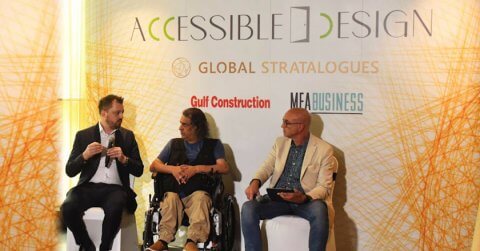Integrating accessibility with safety and security creates inclusive, future-proof spaces that benefit property owners and end-users.
In an insightful discussion between accessibility experts Mark Painter from Australia and Maryan Haider from the US, the focus was on the intersection of accessibility with safety and security and how integrating accessibility from the beginning fosters inclusive environments, boosts property value, and supports sustainability.

Maryan and Mark began by highlighting the three core pillars—safety, security, and accessibility transforming the landscape of modern property design and development. Their insights underscored the long-term financial and societal advantages of prioritising inclusive design, paving the way for visionary real estate projects across the Middle East and beyond. The three critical pillars in property development each contribute uniquely to end-users’ well-being and benefit property owners in the long term. Whether high-rise apartments, sprawling commercial complexes, or community-centred urban developments, integrating these elements from the start enhances the user experience, maintains property value, and minimises future liabilities. The intersection of these principles, particularly with technological advances and inclusive design, offers a powerful approach to building sustainable and competitive assets.
Safety, Security, and Accessibility: A Holistic Approach
Accessibility is often viewed through the lens of inclusivity—ensuring that individuals with disabilities can easily navigate spaces. However, accessibility also complements safety and security by creating environments that are easier to evacuate, safer to navigate, and more efficient to manage. When accessibility is integrated into the design of buildings and spaces, it inherently enhances safety protocols, particularly in emergency situations such as fire evacuations. It also boosts security measures by ensuring that spaces are designed to accommodate all users.
Aaron McDaid, a Middle East leader in Design Confidence, further stressed this connection: “You can’t just design to comply; you’ve got to figure out how to get people out of a building in emergency situations. We looked at areas that would be safe for people with disabilities in the fire stairs. These areas would have communication systems to connect with the fire control room.”

By thinking ahead about how diverse users will move through a building during emergencies, architects and developers can ensure safer outcomes for all, not just those with mobility challenges. These designs also improve overall security, as clear, accessible routes can be extended to ensure easier monitoring and control of movement throughout a property.

The Economic Benefits of Accessibility
For property owners, integrating accessibility from the earliest stages of design is not just a regulatory necessity—it’s a financial advantage. Retrofitting older buildings to comply with modern accessibility standards can be costly. As Maryan Haider noted, “It’s very important to catch things early. And it’s doable; it’s not always costly to make it accessible. A lot of things are small changes that make people’s lives easier, like a small ramp here or there. When you make it expensive, people don’t do it.”
Mark Painter echoed this sentiment: “If you get the people in early, it will save you more money. Retrofitting is costly, and it’s easier to plan for accessibility during the design phase. It’s not just about hitting a regulation—it’s about future-proofing your investment.”
In regions like the GCC, where mega-projects such as Saudi Arabia’s Giga projects are taking shape, accessibility is not only seen as a legal obligation but also as a market differentiator. Ambitious projects require exceeding minimum standards to enhance long-term value and competitiveness.
Maryan Haider also emphasized that while some accessibility features may seem expensive, many improvements are simple and low-cost. “You don’t have to use everything. You just have to choose what’s best for you, best use, and at the same time, laws help control that a lot for us,” she said, pointing out that accessible design doesn’t always require complex solutions but rather thoughtful integration of key features from the outset.
Retrofitting Older Properties: Balancing Costs and Compliance
One of the biggest challenges in accessibility is upgrading older properties to meet modern standards. This is particularly true in heritage buildings or older developments that were not initially designed with accessibility in mind. In these cases, property owners face tough choices between preserving architectural integrity and complying with updated safety and accessibility regulations.
Mark Painter shared his experience from Australia, where accessibility standards have evolved significantly: “In Australia, heritage buildings pose a significant challenge. You have a conflict between building control and access requirements, but you need to find a way to upgrade these buildings to comply with access standards without damaging their heritage value.”
Maryan further expanded on the complexities of integrating accessibility into older properties, noting: “Sometimes they don’t use the technology because it’s not a replacement for the minimum requirements per code. It’s still like, useless. And again, aged people, like all these complicated things—it’s not yet ready for everybody. Maybe for my kids’ generation, it’s easier for them, but not for already aged people. It’s hard to implement everything.”
This issue of balancing costs and compliance is a global one. Retrofitting can be expensive, but it is necessary for long-term viability, as it maintains a building’s competitiveness in a market that increasingly demands accessible spaces.
The Role of Technology in Accessibility and Safety
Emerging technologies, including artificial intelligence (AI), are transforming the way buildings are designed and managed for accessibility, safety, and security. AI-driven tools can monitor user behaviour, identify potential hazards, and provide real-time data to enhance the user experience.
Maryan Haider highlighted the importance of leveraging new technology:
“I think using smart cities, sensors, assistive technologies that are integrated into the design is a fantastic opportunity, especially for people of determination, but also in terms of making shopping malls easier to navigate, for instance, finding your car in the parking lot with the recognition of plates and the multi-sensory guidance.”
Mark Painter pointed to the potential of technology in accessibility, particularly in wayfinding systems: “In Australia, there’s a standard for crossing roads for people with impaired vision. It uses sound to guide them across safely. We’re applying similar principles to developments here in the UAE, where electric vehicles and trams in shopping centres create new challenges.”
AI also plays a role in safety, particularly in fire evacuations and emergency management. The ability to predict the impact of design choices in real time ensures that accessibility is not just a compliance measure but an integral part of building security and usability.
The Importance of Clear, Accessible Guidelines
Maryan Haider also emphasised the need for accessible guidelines with visual support for ease of implementation: “Diagrams are very helpful in accessibility. It’s very important… When we go to construction sites and try to point out issues, different than design. Design, you’re dealing with architects and people who understand your language and the code. There, you’re dealing with contractors who need to know what to do.”
Clear visual guidelines make it easier to ensure accessibility standards are met, especially during the construction phase when precision and clarity are critical to preventing costly mistakes.
Accessibility as a Competitive Advantage
The increasing focus on accessibility is not just about meeting legal requirements; it is about creating properties that stand out in a competitive market. In regions like the GCC, where new developments are competing to attract international investors and residents, accessible design can be a key differentiator.
Oscar Wendel, Chairman of Global Stratalogues, emphasized the competitive edge of accessibility: “Accessibility is such a competitive edge and benefits everybody. It’s not just about doing the right thing; it’s about enhancing the guest experience and ensuring that your property appeals to the widest possible audience.”
As demographics shift and the demand for accessible living spaces grows, developers recognize that accessible design benefits all, including people with disabilities, the elderly, and families with young children. Accessible spaces create environments that work for everyone, providing a long-term competitive advantage for developers.
A Long-Term Investment in Value and Usability
Safety, security, and accessibility are intertwined. When integrated into a building’s design and management, they create spaces that are not only compliant but also more valuable and usable. For property owners, the benefits of investing in accessibility go beyond regulatory compliance—they enhance a property’s overall appeal, attract a broader range of tenants or buyers, and improve the long-term sustainability of the asset.
As Maryan Haider succinctly put it:
“Accessibility doesn’t have to be complicated or expensive, but needs to be prioritised. When it is, everyone benefits—property owners and end-users alike.”
By embracing the intersection of safety, security, and accessibility, developers and property owners can future-proof their assets, ensuring long-term value and usability for diverse populations.
Image Credit: Design Confidence, PIF © & Hydrock





